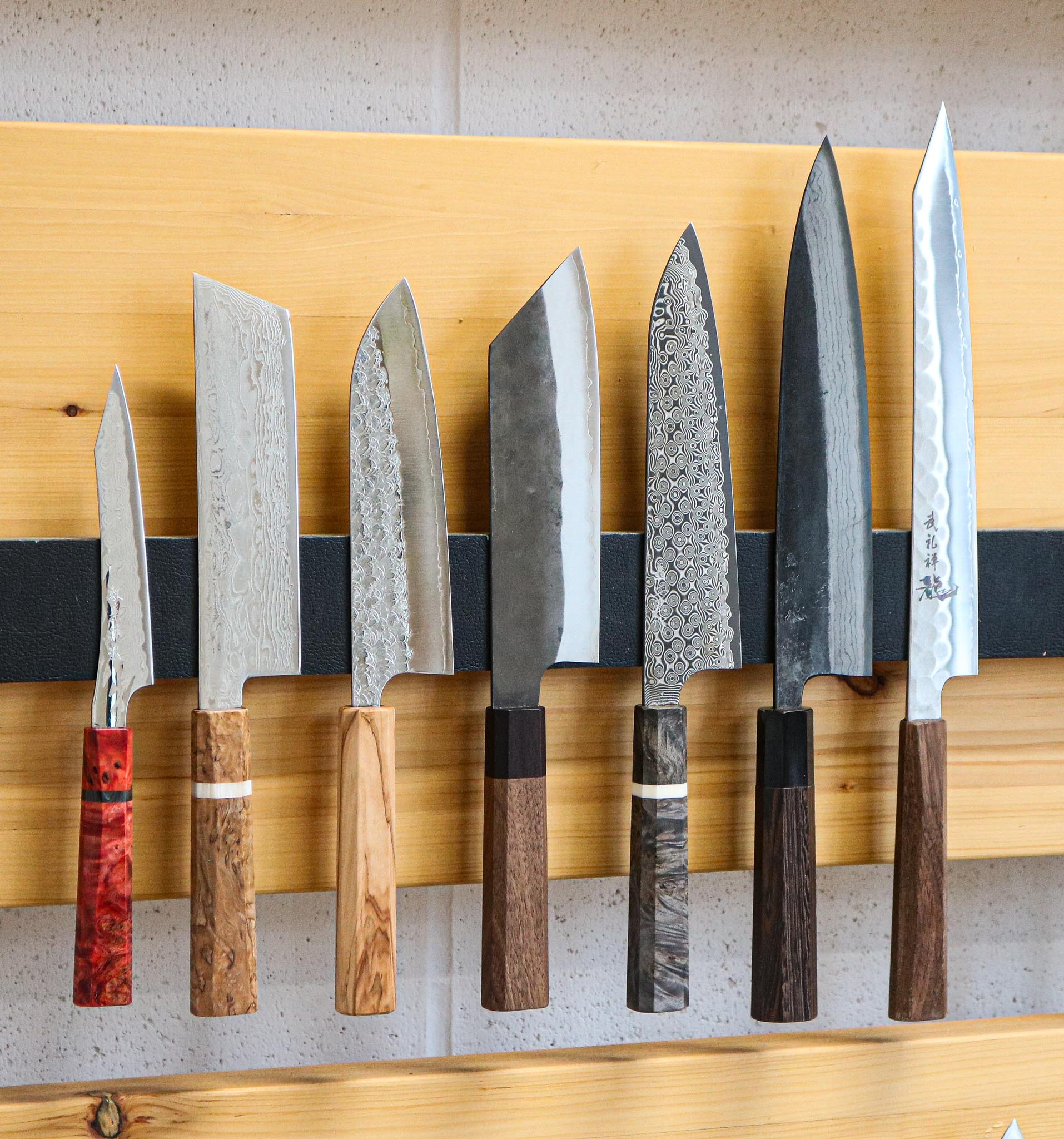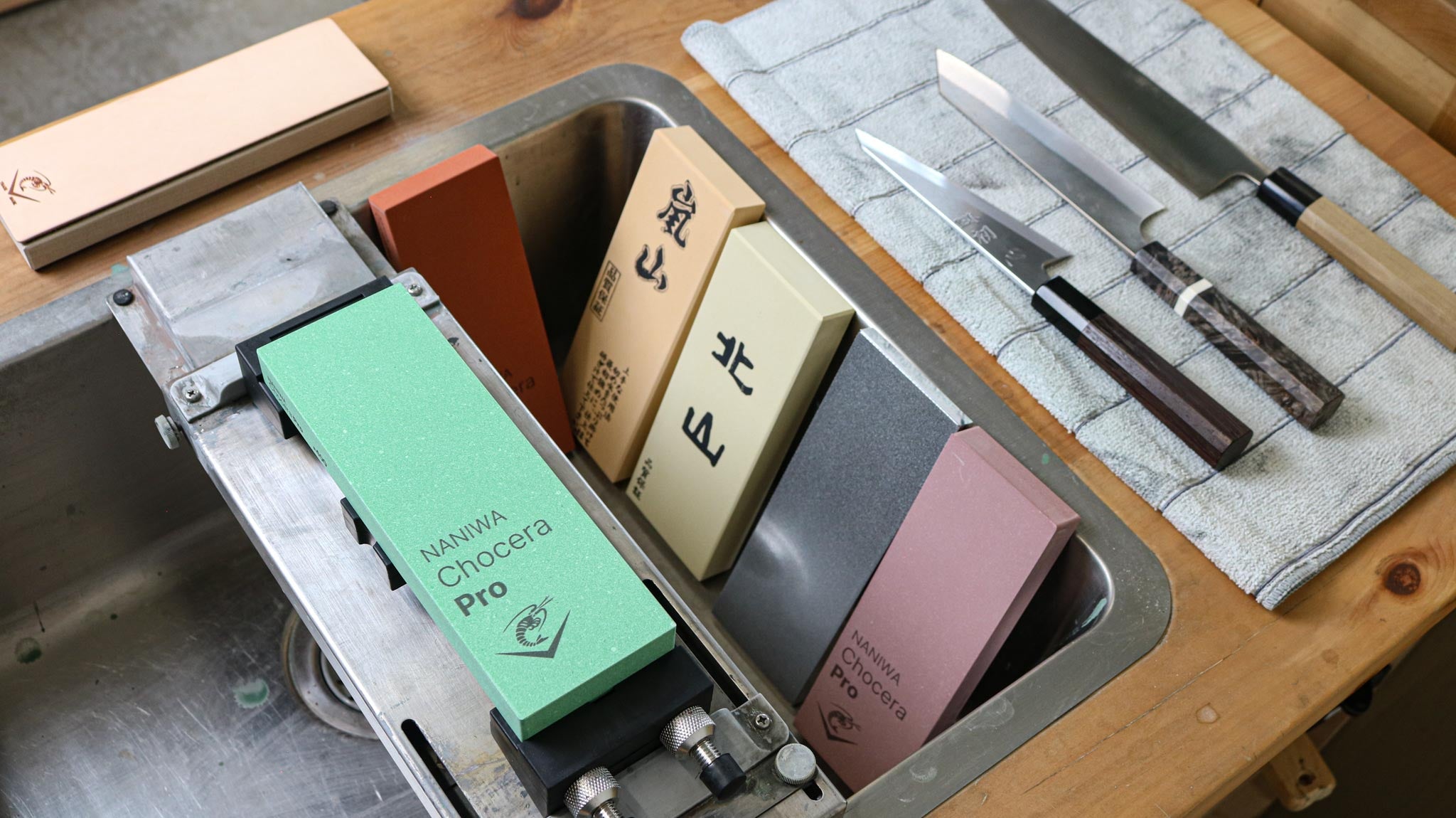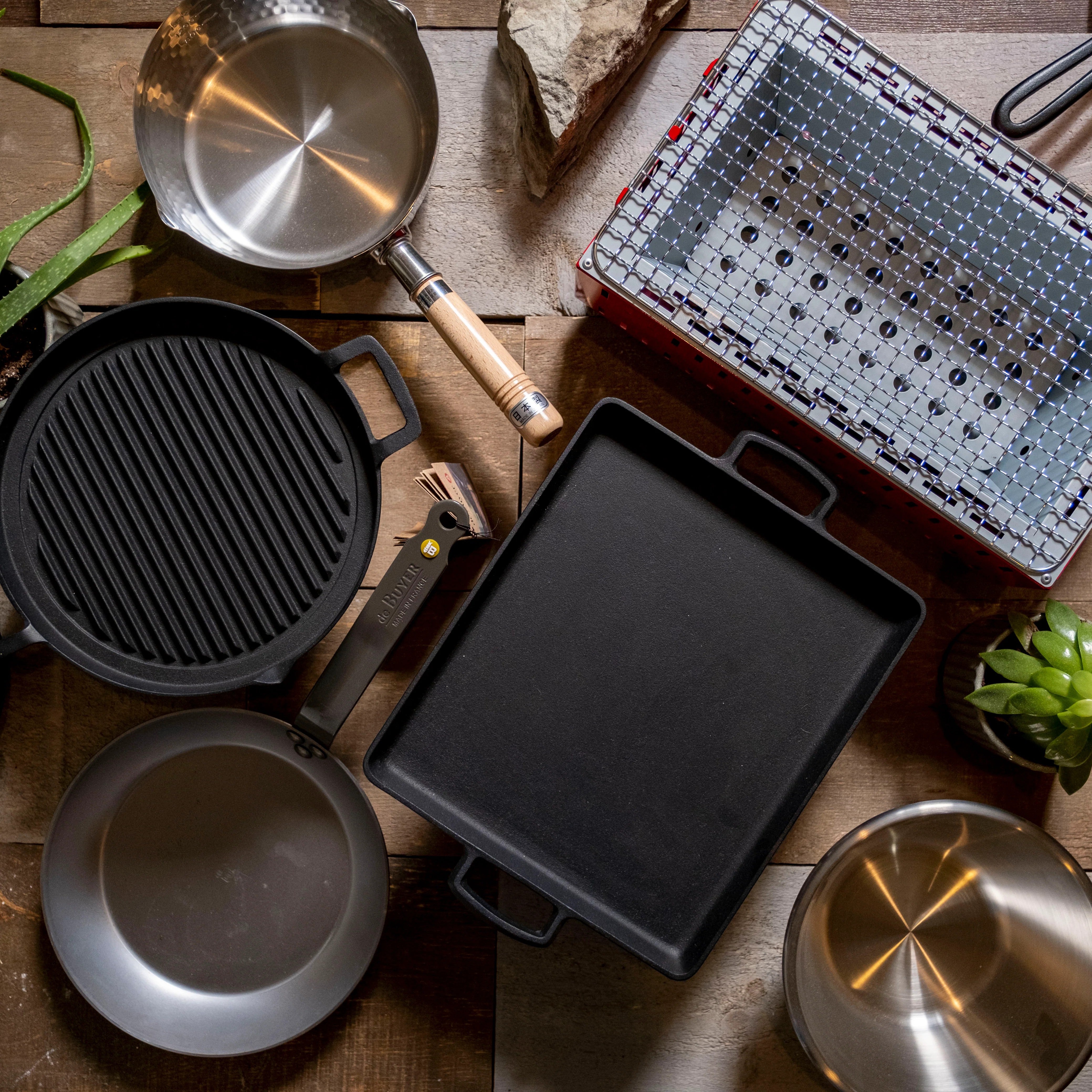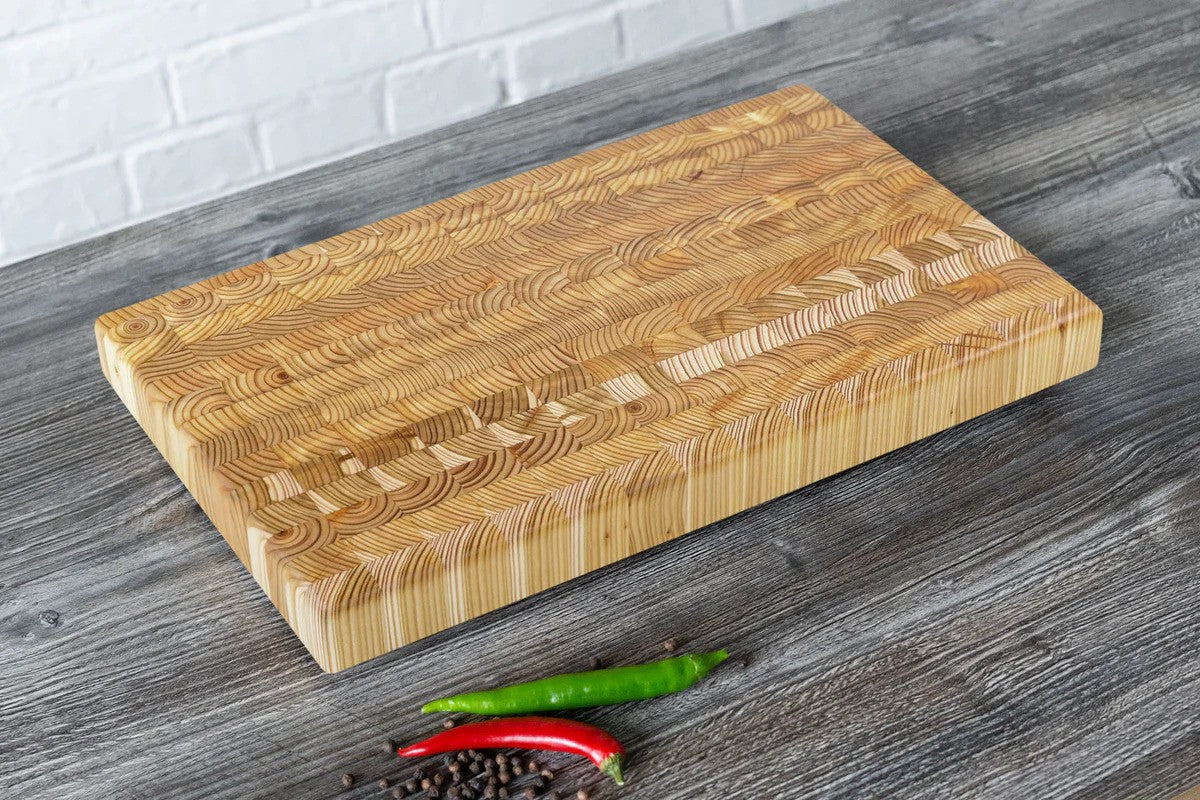Menu

The Definitive Guide To Knife Maintenance
All Japanese knives fit into three tiers of maintenance, we’re going to break them down right now.
Those three tiers are fully stainless, stainless clad, and iron clad. Gage and I would like to make the point that all knives should be maintained in the same way, the difference is that knives made from carbon will punish you more for your neglect than a stainless steel knife would. Stick around to the end and we’ll also touch on handle maintenance.
Stainless
So let’s start with the easiest tier in regards to maintenance, Stainless steel. As the name implies, stainless should never rust or discolour. There aren’t really any special care instructions for stainless so we’ll use this time go over general maintenance for all your knives.
- Don’t cut through anything you wouldn’t bite through, such as frozen foods, hard candies or bones.
- Wipe your knife often keeping it dry and clean. Even with stainless it's still a good habit to build to keep a damp rag on your station and wipe your knife and board down often. Even if the knife is stainless your station will be cleaner and more organized, meaning less chance of cross contamination or knocking the knife off the counter.
- No dishwashers or soaking, as it can ruin the handle and rust the blade. Thats right, its stain-LESS not stain-PROOF, higher carbon content stainlesses found in Japanese knives and even European stainless knives can still rust when pushed to the limit by soaking or repeated trips to the dishwasher. While this won't be near as drastic as it would be with a carbon knife it's still a good practice to hand wash and dry right away!
- No torquing of the blade! You should be using it in as forward and back, up and down motion as you can without twisting. This applies to taking a thick peel off of squash or similar veggies and turning the knife, the two hand speed chopping technique people use on herbs, which is fine but watch the pressure you're applying into the board while twisting the knife to the next chop, and any and all prying tasks!
- Don’t scrape the board with your knife, while unlikely to damage your knife, this will roll the edge over making it dull it super quick and ruin your edge.
- The type of cutting board is important. Glass, bamboo, and granite are terrible materials for cutting boards, plastic is not great but not as bad as the others. Ideally you'll be using an end grain wooden cutting board or a hi-soft rubberized cutting board.
- And last but not least. Stop opening cans with your knife, there I said it, stop..stop it.
Iron Clad
A carbon knife means not just that it has carbon in it, as all steel has a base of iron and carbon, however it implies the lack of chromium that makes a knife stainless. Well the benefits of this are plentiful:
It comes with a sacrifice, that the blade is susceptible to rust and discolouration.
Rust will form when the steel oxidizes too quickly, and can happen in a matter of minutes if the knife is left wet or soaking in the sink.
This is not to be confused with a patina, which is a protective coating that forms on the blade over time from coming in contact with different foods with different PH levels.

This is RUST not patina!
Remember, rust is red, where patina can be just about any colour but red. But will eventually turn dark brown/grey/black if you build a strong patina.
A patina is very similar to the seasoning in a cast iron pan, you slowly build up a strong, resilient seasoning and your pan is non stick, and if you build a strong, dark patina on a carbon knife it will be more resilient to rusting from coming in contact with water.
However much like if you were to simmer an acidic tomato sauce in a cast iron pan it will eat your seasoning away and you’ll have to rebuild that nonstick surface, same goes for your carbon knives if you were to cut an acidic food like citrus, tomatoes, or onions and not wipe the knife down immediately, no matter how far along your patina is, it will eat away the patina. With that said quickly frying some tomato slices in cast iron won't hurt the seasoning, especially if you wipe the pan out right away after, and if you quickly wipe your knife afterwards you don't need to avoid these ingredients.
It is important to wipe your carbon knife down immediately after use before it goes down on the board.
It's not that this is a lot of extra work, and this is really all the extra maintenance that a carbon knife requires, but it requires building the habit of wiping it down quickly, every single time. Which I think is a pretty good trade off for all the benefits of carbon if you ask us!
Stainless Clad
Stainless clad knives like the name implies, have a carbon steel core to get the benefits of carbons edge retention and ease of sharpening, sandwiched between two pieces of stainless that protect the majority of the blade from rust and discolouration and can also add rigidity and strength to the blade.
Well this sits somewhere in-between stainless and carbon for maintenance I saved it for last because while it does make a knife easier to care for, you still need to wipe it down quickly and treat it like a full carbon blade because there is still exposed carbon. However should something go wrong and you were to rust the knife, its just the small sliver of core steel peeking out at the edge that you’ll have to clean up. Since the care instructions are the same as the carbon, I'll take this time to talk about how!
Firstly, if you catch it quickly while you’re cooking, you can most of the time rub it off with a rag and some elbow grease, I recommend trying this first.
If that doesn’t cut it and you have some tricky rust, you can make a slurry of baking soda and water and leaving it on for a few minutes (longer if needed) and rub it off with the rag like before. This is my preferred method as it doesn’t use abrasives and can clean up rust peaking through a kurouchi finish without destroying it. Be advised that this technique will clean off your patina as well.
The last technique is to use an abrasive. At the shop we use rust erasers. Like the name implies its like a pencil eraser but with a fine ceramic grit throughout and you use it the same way. We suggest starting with a light pressure and only increasing the pressure as necessary and using long strokes in the same direction as it can leave fine scratches on the knife and they’re much less noticeable with a consistent scratch pattern.
Bonus Tier Handles

Japanese or Wa handles have a pin tang as shown here, and are either burned or glued into the handle. These guys have their benefits of being overall lighter and more nimble but they are not as resilient with water as western style handles. With that said if the handle ever does loosen or come apart it is much easier and cheaper to repair or replace. While some people worry that the pin tang design isn’t as sturdy as a full tang western handle, which is fair, I’d like you to consider that if you’re being rough enough to seriously damage a wooden handle, the blade will have been damaged well before that point and you should be correcting your technique or have a lighter hand.

Western style handles, as shown above, have a full tang design and usually a few rivets going through the handle to help secure the scales. These knives tend to have a more handle heavy balance and do better with moisture. Should something ever go wrong with these handles they are much more difficult and expensive to repair, though it is unlikely in my experience that you will have to repair either handle type.
With that said its more important in my opinion to pick the handle style that is more comfortable to your hands, and looks good to you, as at the end of the day if you aren’t abusing your knife, is strictly preference.
Alright folks, that’s it, knife maintenance 101. If we missed any points or you have any questions leave em down below and until next time, stay sharp.
A carbon knife means not just that it has carbon in it, as all steel has a base of iron and carbon, however it implies the lack of chromium that makes a knife stainless. Well the benefits of this are plentiful:
- Better edge retention
- Faster sharpening
- Jumps back to life quicker on a honing rod or strop
- Usually, but not always, better bang for your buck
It comes with a sacrifice, that the blade is susceptible to rust and discolouration.
Rust will form when the steel oxidizes too quickly, and can happen in a matter of minutes if the knife is left wet or soaking in the sink.
This is not to be confused with a patina, which is a protective coating that forms on the blade over time from coming in contact with different foods with different PH levels.

This is RUST not patina!
Remember, rust is red, where patina can be just about any colour but red. But will eventually turn dark brown/grey/black if you build a strong patina.
A patina is very similar to the seasoning in a cast iron pan, you slowly build up a strong, resilient seasoning and your pan is non stick, and if you build a strong, dark patina on a carbon knife it will be more resilient to rusting from coming in contact with water.
However much like if you were to simmer an acidic tomato sauce in a cast iron pan it will eat your seasoning away and you’ll have to rebuild that nonstick surface, same goes for your carbon knives if you were to cut an acidic food like citrus, tomatoes, or onions and not wipe the knife down immediately, no matter how far along your patina is, it will eat away the patina. With that said quickly frying some tomato slices in cast iron won't hurt the seasoning, especially if you wipe the pan out right away after, and if you quickly wipe your knife afterwards you don't need to avoid these ingredients.
It is important to wipe your carbon knife down immediately after use before it goes down on the board.
It's not that this is a lot of extra work, and this is really all the extra maintenance that a carbon knife requires, but it requires building the habit of wiping it down quickly, every single time. Which I think is a pretty good trade off for all the benefits of carbon if you ask us!
Stainless Clad
Stainless clad knives like the name implies, have a carbon steel core to get the benefits of carbons edge retention and ease of sharpening, sandwiched between two pieces of stainless that protect the majority of the blade from rust and discolouration and can also add rigidity and strength to the blade.
Well this sits somewhere in-between stainless and carbon for maintenance I saved it for last because while it does make a knife easier to care for, you still need to wipe it down quickly and treat it like a full carbon blade because there is still exposed carbon. However should something go wrong and you were to rust the knife, its just the small sliver of core steel peeking out at the edge that you’ll have to clean up. Since the care instructions are the same as the carbon, I'll take this time to talk about how!
Firstly, if you catch it quickly while you’re cooking, you can most of the time rub it off with a rag and some elbow grease, I recommend trying this first.
If that doesn’t cut it and you have some tricky rust, you can make a slurry of baking soda and water and leaving it on for a few minutes (longer if needed) and rub it off with the rag like before. This is my preferred method as it doesn’t use abrasives and can clean up rust peaking through a kurouchi finish without destroying it. Be advised that this technique will clean off your patina as well.
The last technique is to use an abrasive. At the shop we use rust erasers. Like the name implies its like a pencil eraser but with a fine ceramic grit throughout and you use it the same way. We suggest starting with a light pressure and only increasing the pressure as necessary and using long strokes in the same direction as it can leave fine scratches on the knife and they’re much less noticeable with a consistent scratch pattern.
Bonus Tier Handles

Japanese or Wa handles have a pin tang as shown here, and are either burned or glued into the handle. These guys have their benefits of being overall lighter and more nimble but they are not as resilient with water as western style handles. With that said if the handle ever does loosen or come apart it is much easier and cheaper to repair or replace. While some people worry that the pin tang design isn’t as sturdy as a full tang western handle, which is fair, I’d like you to consider that if you’re being rough enough to seriously damage a wooden handle, the blade will have been damaged well before that point and you should be correcting your technique or have a lighter hand.

Western style handles, as shown above, have a full tang design and usually a few rivets going through the handle to help secure the scales. These knives tend to have a more handle heavy balance and do better with moisture. Should something ever go wrong with these handles they are much more difficult and expensive to repair, though it is unlikely in my experience that you will have to repair either handle type.
With that said its more important in my opinion to pick the handle style that is more comfortable to your hands, and looks good to you, as at the end of the day if you aren’t abusing your knife, is strictly preference.
Alright folks, that’s it, knife maintenance 101. If we missed any points or you have any questions leave em down below and until next time, stay sharp.
- Choosing a selection results in a full page refresh.






